Painkillers are among the most commonly used medications in the world. From relieving headaches and back pain to managing chronic conditions, these drugs play a crucial role in improving daily life. However, with easy access and frequent use comes a serious concern — painkiller overdose.
Whether you take over-the-counter (OTC) pain relievers like ibuprofen and acetaminophen or prescription medications such as Tramadol, Tapentadol, or Carisoprodol, using them incorrectly can lead to dangerous consequences, including organ damage, dependence, and even death.
In this detailed guide, we’ll help you understand the safe use of painkillers, how to avoid overdose, and what steps to take if you or someone you know may be at risk.
Understanding Painkiller Overdose
A painkiller overdose occurs when you take more than the recommended or prescribed dose of a medication. This can be intentional or accidental. Overdose risks vary depending on the type of painkiller you take.
1. Types of Painkillers
a. Over-the-Counter (OTC) Painkillers:
- Paracetamol (Acetaminophen): Commonly used for mild pain and fever.
- NSAIDs (Ibuprofen, Naproxen, Aspirin): Used for inflammation, headaches, and muscle pain.
b. Prescription Painkillers:
- Opioids (Tramadol, Tapentadol, Oxycodone, Morphine): Strong painkillers for severe pain.
- Muscle Relaxants (Carisoprodol, Cyclobenzaprine): Used for muscle spasms.
- Anticonvulsants (Pregabalin, Gabapentin): Used for nerve pain.
Each category carries unique risks. For example, acetaminophen overdose can cause liver damage, while opioid overdose can depress breathing and cause coma or death.
Common Causes of Painkiller Overdose
Painkiller overdose doesn’t always result from intentional misuse. Sometimes it happens by accident due to poor understanding or mixing medications. Here are the most frequent causes:
- Taking multiple painkillers with the same ingredient
– For example, using two products containing acetaminophen can double your dose unknowingly. - Ignoring prescription instructions
– Exceeding the prescribed dosage or taking doses too close together increases toxicity. - Combining painkillers with alcohol or sedatives
– Mixing opioids or sleeping pills with alcohol can slow down your breathing and heart rate dangerously. - Self-medicating chronic pain
– When pain persists, people often increase doses without consulting a doctor. - Buying unverified medicines online
– Fake or contaminated pills from unlicensed sources can be much stronger or contain harmful substances.
Symptoms of Painkiller Overdose
Recognizing overdose symptoms early can save lives. Symptoms depend on the type of medication, but here are the most common warning signs:
Acetaminophen Overdose Symptoms:
- Nausea and vomiting
- Loss of appetite
- Yellowing of the eyes or skin (liver damage)
- Fatigue or confusion
Opioid Overdose Symptoms:
- Slow or irregular breathing
- Pinpoint pupils
- Blue lips or fingernails
- Loss of consciousness or coma
NSAID Overdose Symptoms:
- Stomach pain or bleeding
- Vomiting blood or black stools
- Dizziness or confusion
- Kidney failure in severe cases
If you notice any of these symptoms, seek emergency medical help immediately.
Also Read: Tapentadol 200 mg: A Complete Guide to Dosage, Side Effects & Safety
How to Avoid Overdosing on Painkiller
Here are proven, practical steps to prevent overdose and ensure safe painkiller use:
1. Follow the Prescription Strictly
Always take the exact dose recommended by your doctor. Never assume that more pills will bring faster relief — they won’t. Overdosing only increases side effects and risks organ damage.
2. Avoid Mixing Painkillers Without Guidance
Don’t combine two or more painkillers unless a healthcare provider explicitly approves it. For example, taking ibuprofen with paracetamol is sometimes safe, but mixing Tramadol with alcohol or sleeping pills can be fatal.
3. Check the Labels Carefully
Many OTC medications contain hidden pain-relief ingredients. Always read the packaging to check for acetaminophen, NSAIDs, or opioids to avoid double dosing.
4. Avoid Alcohol While Taking Painkillers
Alcohol intensifies the sedative effects of many painkillers and can damage the liver, especially when combined with acetaminophen or opioids.
5. Use a Medication Schedule
Keep a written record or use a phone reminder app to track when you take your medication. This helps prevent accidentally taking multiple doses too close together.
6. Store Medications Safely
Keep painkillers out of reach of children and others who may misuse them. Store them in their original containers to avoid confusion.
7. Dispose of Unused Pills Properly
Expired or leftover medicines can be dangerous if consumed later. Take them to a local pharmacy for safe disposal.
8. Buy Medicines from Verified Pharmacies Only
When ordering online, always choose a licensed and trusted pharmacy like PainReliefHub24.com. We supply genuine, FDA-approved pain relief medications and ensure every order is handled with safety and discretion.
9. Consult a Doctor Before Increasing Dose
If your pain isn’t relieved by the prescribed dosage, talk to your healthcare provider. Never self-adjust your dose — tolerance and dependency can develop quickly with opioids and muscle relaxants.
10. Understand the Medication’s Half-Life
Every drug stays in your system for a certain period. Taking another dose before the previous one wears off increases the risk of overdose.
Read More :- Balancing Natural and Medical Approaches to Pain Relief: What Works Best?
Medical Emergency: What to Do if Overdose Happens
If you suspect an overdose:
- Call Emergency Services (911 in the USA) immediately.
- Do not induce vomiting unless advised by a medical professional.
- Provide details — medication name, dosage, and time of ingestion.
- Stay with the person until help arrives.
- If opioid overdose is suspected, administer naloxone if available (can temporarily reverse effects).
Time is critical — early action can prevent irreversible organ damage or death.
Safe Alternatives and Long-Term Pain Management
Painkillers are not the only way to manage chronic or recurring pain. Explore safer, non-drug options that can complement medication use:
- Physical therapy and stretching exercises
- Acupuncture and massage therapy
- Heat and cold therapy for joint pain
- Mindfulness and relaxation techniques
- Anti-inflammatory diet (rich in omega-3, turmeric, and fruits)
By combining these approaches, you can often reduce your dependence on strong painkillers over time.
Key Takeaways
| Do’s ✅ | Don’ts ❌ |
|---|---|
| Take medicine only as prescribed | Never double your dose for faster relief |
| Read medication labels carefully | Don’t mix drugs with alcohol |
| Use a reminder system | Avoid sharing medications |
| Buy from licensed pharmacies | Don’t buy fake or unknown brands |
| Consult your doctor regularly | Never stop medications suddenly without advice |
Final Thoughts
Painkillers can be life-changing when used correctly — helping you live comfortably and productively. However, the same drugs can become dangerous when misused or overused.
Understanding your medication, following prescriptions carefully, and buying only from verified online pharmacies like PainReliefHub24.com are the keys to safe, effective pain management.
If you ever feel unsure about your dosage or side effects, reach out to your healthcare provider immediately. Responsible painkiller use isn’t just about relief — it’s about protecting your health and your future.
Also Read: Managing Neuropathic Pain: Lifestyle Hacks, Diet & Supplement Support












One Response